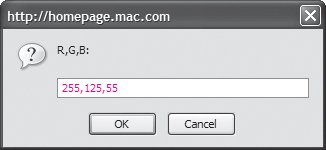1. |
javascript:var s,i,n,h='',
Start off the bookmarklet by initializing four variables.
|
2. |
The variable x is set to the valid hexadecimal values.
|
3. |
This line prompts the user for the requested RGB values, separated by commas, as shown in Figure 17.18.

|
4. |
If the user entered anything, continue with the code. Otherwise, the value of c will be null, and the bookmarklet ends, as in step 10, below.
|
| |
5. |
Split the entry in c, separated by commas, and put the result into the s array.
|
6. |
Loop around the following lines once for each of the three red, green, and blue color values.
|
7. |
Turn the current element of s into a number, and save it as n.
|
8. |
h+=x.charAt(n>>4)+x.charAt(n&15)}
This line converts n into 2 hexadecimal digits and adds the result to h.
|
9. |
void(prompt('Hexcolor:','#'+h))}
The result (preceded by a pound sign, ready to be copied into an HTML page) is displayed via a prompt command, as shown in Figure 17.19. It's done this way instead of with an alert, so that we can copy the code and paste it later.

|
10. |
If nothing was entered in step 3, step 4 causes the code to jump to this step, where nothing happens.
|